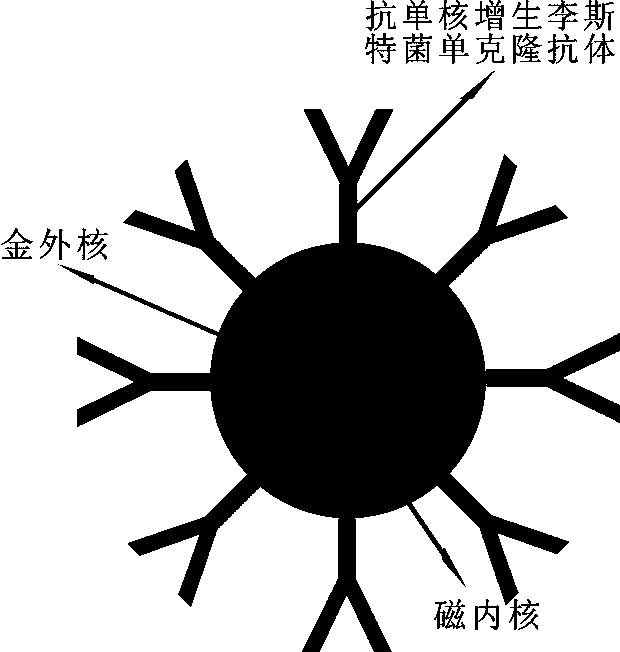Listeria monocytogenes enrichment and rapid detection method
A technology for Listeria and detection methods, applied in measurement devices, instruments, scientific instruments, etc., can solve problems such as sensitivity limitations, affect results and sensitivity, achieve high coupling rate, small coefficient of variation, reduce workload and Effect of bacterial contamination probability
- Summary
- Abstract
- Description
- Claims
- Application Information
AI Technical Summary
Problems solved by technology
Method used
Image
Examples
Embodiment 1
[0027] Example 1: Detection of Listeria monocytogenes in milk using nano-gold magnetic particles
[0028] 1. Preparation of gold magnetic particles coupled with monoclonal antibody:
[0029] 1.1 Treatment of nano-gold magnetic particles: Take 200-400 μL of coupling buffer in a 2 mL centrifuge tube, mix with 0.5-1.0 mg of 50 nm nano-gold magnetic particles, magnetically separate for 3-5 minutes, and discard the supernatant.
[0030] 1.2 Coupling reaction: Take 200-300 μg of the prepared anti-Listeria monocytogenes monoclonal antibody, mix with 0.5-1.0 mg of 50 nm nano-gold magnetic particles, and place in 1 mL of coupling buffer. At a temperature of 37°C, place on a rotator with a rotational speed of 10-15 rpm, couple for 30-60 min, magnetically separate for 3-5 min and discard the supernatant. Wash 3 times with 1 mL of wash buffer.
[0031] 1.3 Blocking: After washing, mix 1 mL of blocking agent with magnetic beads to block for 1 hour.
[0032] 2. Capturing Listeria monoc...
Embodiment 2
[0040] Example 2: Detection of Listeria monocytogenes in beef using nano-gold magnetic particles
[0041] 1. Preparation of gold magnetic particles coupled with monoclonal antibody:
[0042] 1.1 Treatment of nano-gold magnetic particles: Take 200-400 μL of coupling buffer in a 2 mL centrifuge tube, mix with 0.5-1.0 mg of 50 nm nano-gold magnetic particles, magnetically separate for 3-5 minutes, and discard the supernatant.
[0043] 1.2 Coupling reaction: Take 200-300 μg of the prepared anti-Listeria monocytogenes monoclonal antibody, mix with 0.5-1.0 mg of 50 nm nano-gold magnetic particles, and place in 1 mL of coupling buffer. At a temperature of 37°C, place on a rotator with a rotational speed of 10-15 rpm, couple for 30-60 min, magnetically separate for 3-5 min and discard the supernatant. Wash 3 times with wash buffer.
[0044] 1.3 Blocking: After washing, mix 1 mL of blocking agent with magnetic beads to block for 1 h.
[0045] 2. Capturing Listeria monocytogenes in...
PUM
| Property | Measurement | Unit |
|---|---|---|
| Particle size | aaaaa | aaaaa |
Abstract
Description
Claims
Application Information
 Login to View More
Login to View More - R&D
- Intellectual Property
- Life Sciences
- Materials
- Tech Scout
- Unparalleled Data Quality
- Higher Quality Content
- 60% Fewer Hallucinations
Browse by: Latest US Patents, China's latest patents, Technical Efficacy Thesaurus, Application Domain, Technology Topic, Popular Technical Reports.
© 2025 PatSnap. All rights reserved.Legal|Privacy policy|Modern Slavery Act Transparency Statement|Sitemap|About US| Contact US: help@patsnap.com



